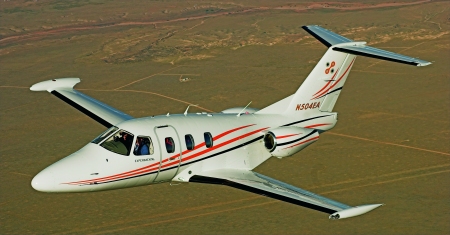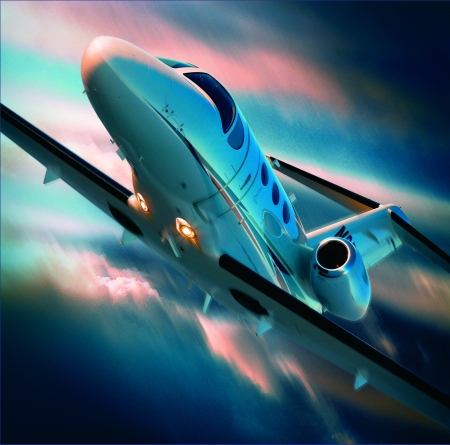Alan Klapmeier, chief executive of general aviation phenomenon Cirrus Design, has finally answered the much-asked question. “We will not develop a very light jet,” he says, adding, after a pause: “But we are looking at the concept of a personal jet.”
His distinction may sound like hair-splitting – particularly after the battle fought by manufacturers to shake off the microjet tag in favour of the more serious sounding very light jet (VLJ) – but the fact that Klapmeier sees a difference is significant.
Now a recognised sector of the business jet spectrum, the VLJ class covers aircraft ranging from Diamond’s four-seat, single-engined D-Jet to Embraer’s Phenom 100, which has a cabin rivalling that of larger entry-level business jets. What they have in common is that they are lighter – and cheaper – than the smallest business jets now available.
Klapmeier’s comments suggest the VLJ sector may yet stratify into two, or possibly three, segments that reflect not only the size of the aircraft, but also their price, performance and target market. The divisions are becoming evident as the orderbooks for these new small jets begin to build.
Emerging buyers
Three main groups of VLJ buyers are emerging – owner/operators, corporate flight departments and air-taxi operators – with the mix represented in the backlogs reflecting the different price and performance levels of the aircraft (see table).
Eclipse Aviation, the VLJ market leader, has 2,357 orders and options for its $1.4 million Eclipse 500 – two-thirds of them from air-taxi operators. Adam Aircraft claims 57 owner/operator and 225 fleet orders for its $2.25 million A700. Cessna, meanwhile, has few if any air-taxi customers in its 230-order backlog for the Citation Mustang, but regards the $2.4 million aircraft as an entry-level business jet, and not a VLJ.

Although it outweighs the Mustang, the $2.75 million Phenom 100 is promoted as a VLJ. Embraer has built its business case for the aircraft around the same private and corporate buyers targeted by Cessna, but sees the air-taxi market as a likely bonus. The company has just begun taking orders, so the mix has yet to emerge.
None of these designs represent the market niche that interests Klapmeier, who wants an aircraft that will be a natural step up from Cirrus’s SR22 four-seat piston single. He is looking at a single-engined jet costing less than $1 million and with limited performance so that it is easy and safe to fly.

This sounds similar to Diamond’s D-Jet, a single-turbofan five-seater with a maximum cruise speed of 315kt (580km/h), maximum operating altitude of 25,000ft (7,600m) and a target price under $1 million. This is a different beast to the Phenom, with its business jet-class 380kt cruise and 41,000ft altitude capability.
Honeywell in its latest business aviation outlook provides its first estimate of the size of the emerging general aviation jet market, at the same time recognising the sector’s stratification. The company groups the Mustang and Phenom 100 in a very-light jet sector expected to exceed 1,900 deliveries over the 10 years to 2015; while the D-Jet, Eclipse and A700 are grouped in an ultra-light/personal jet market forecast at between 4,500 and 5,500 aircraft over the next decade.
The cut-off between the very-light and ultra-light jets in Honeywell’s survey is at around the $2-2.5 million mark. “Below that price you get into owner-pilot aircraft like the Eclipse and A700,” says Charles Park, director market analysis. “These are not typical flight-department aircraft, although there is some cross-over.”
Honeywell’s survey indicates a potential 10-year demand from corporate flight departments for 800-900 ultra-light jets, but this is dwarfed by the 3,700-4,500 aircraft expected to be delivered to owner-pilots over the same period. The total excludes any demand from fractional-ownership or air-taxi operators.
Embraer’s forecast of 2,515 VLJ deliveries between 2006 and 2016 covers aircraft ranging from the D-Jet to the Phenom 100, and so is not directly comparable with Honeywell’s. The total also excludes the air-taxi market, which the Brazilian manufacturer tentatively estimates at 2,500-3,000 aircraft over the 10-year period.
Lack of agreement
While these surveys help put a rough order of magnitude on the market for small jets, they also underline the lack of industry agreement on what exactly constitutes the VLJ market. From the orderbooks, the customer base for the Eclipse and A700 appears to differ from that for the Mustang, and perhaps the Phenom.
Klapmeier argues there may be a third, distinct market. The Cirrus boss made his “personal jet” announcement earlier this month at the annual expo of the Aircraft Owners and Pilots Association (AOPA), an organisation with more than 400,000 US members that represent the company’s core customer base.
Cirrus is today the second largest manufacturer of piston-single aircraft. The company delivered almost 460 of its all-composite SR22s last year, making it the general aviation industry’s best-selling model. It is the success of this high-performance, technically advanced aircraft that has led to spec ulation about Cirrus’s plans for a jet.
The speculation is now over, sort of. “We are not far enough along to announce a product. Performance, pricing and timing are not nailed down,” says Klapmeier. The announcement at the AOPA Expo was instead intended to make clear Cirrus has no plans for a “big” small jet like the Eclipse or even Mustang.
“The VLJ definition is overly broad. There is a separate market niche below the Eclipse,” says Klapmeier. Studies of a single-engined jet a part of Cirrus’s drive to stimulate demand for personal air transport, which includes getting into the air-taxi business (see P38). “Personal aircraft have a huge benefit beyond current pilots. We have to open up the market to a lot more people,” he says.
The stylish SR22 with its glass cockpit has attracted new flyers and buyers to general aviation, some of whom are now looking for something new, Klapmeier says. “A lot of people new to the industry are flying SR22s, and they want their learning to continue. We think we can offer the owner/operator a single-engined jet with similar speeds and altitudes, and similar complexity, as the next natural step from the SR22.”
The Cirrus personal jet, when it emerges, would not complete directly with existing VLJs on price or performance. “This is not an either/or. We think it will make lots of customers for Eclipse, just as Eclipse will make customers for Mustang,” Klapmeier says. “We are looking at a requirement for lower cost and lower operator experience.”
The reason Klapmeier is keen to distinguish between the personal jet and very-light jet lies in the different training and operating requirements that could apply. Training for VLJs like the Eclipse, Mustang and Phenom is being modelled on that required for larger business jets because the aircraft have similar speed and altitude capabilities, which go well beyond the experience levels of most piston or turboprop owners.
“We do not accept that all pilots should train the way airline pilots do,” says Klapmeier. “The personal jet will have different training and currency requirements than corporate jets, because it will operate closer to the way the SR22 is flown.” This would be achieved by deliberately limiting the jet’s performance to stay within the capabilities of a pilot moving up from a high-performance piston.
“We should make sure the aircraft is easier to operate and use, instead of making sure the pilot is trained to avoid things,” Klapmeier says. An example is limiting personal jet’s altitude to “around 25,000ft [7,600m]”, rather than the 41,000ft capability of the Eclipse, Mustang and most business jets. “You have to train a pilot that it’s dangerous at 41,000ft. If you fly a personal jet, you do not go up there,” he says.
Bridging a gap
Eclipse has given its VLJ true business-jet performance because the company sees its market in bridging the broad gap between piston singles and twins and light jets. As a result, the Eclipse 500 spans a wide market from owner/operators moving up to jets to corporate flight departments adding a smaller aircraft. Speed and altitude capability is also important to the air-taxi market, which hopes to attract customers by offering faster point-to-point times than either the airlines or the highways.
With two-thirds of its backlog tied to the air-taxi market, including announced orders for 239 aircraft from start-up Dayjet and 30 from established US operator Linear Air, Eclipse is leading this emerging market. Dayjet is running increasingly sophisticated simulations of its air-taxi operation ahead of a roll-out of the service some time between April and June next year in a yet-to-be-announced region of the USA.
The timing depends on certification of the Eclipse, which is still planned for the end of March next year. Dayjet will begin with five aircraft in two locations, but plans to double its size every three months, with all 239 aircraft on firm order to be in service within 24 months, says chief executive Ed Iacobucci.
Just as the Eclipse 500’s low acquisition and operating costs are key to the success of Dayjet’s business model, so the operator’s success key is to Eclipse’s plans to push its production rate up to four aircraft a day. Adam, similarly, is looking to the air-taxi market for volume. Embraer, meanwhile, is not counting on air-taxi sales, but believes the market will emerge. “Air taxi is an interesting opportunity, and we believe it will work,” says Louis Carlos Affonso, senior vice-president, executive aviation.
New US light-jet developer Spectrum Aeronautical believes the air-taxi model can be exported to Europe, and has set up a Luxembourg-based subsidiary to “evangelise” the concept. “Europe is not thinking about the air-taxi revolution, but I think it will happen,” says chairman Linden Blue. “We will be the breeders of a new market in the next 10 years.”
Spectrum Aviation Europe is launching efforts to convince potential operators that there is “huge potential in the underutilised airports in Europe”, says chief executive Stefano Sturlese. “European congestion is at big airports, not in airspace, and small aircraft can make better use of small airports,” he says, adding: “The very-light jet is a powerful tool to relieve congestion at the big airports.”
Cirrus’s venture into the air-taxi market through buying US SR22 operator SATSair could provide a ready market for its personal jet. But Klapmeier cautions the company has not decided whether to develop the aircraft. “We are comfortable it is doable technically, but other things might come along first,” he says.
GRAHAM WARWICK / WASHINGTON DC
Source: Flight International























